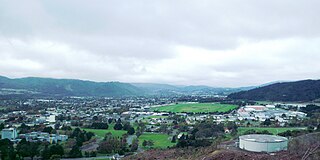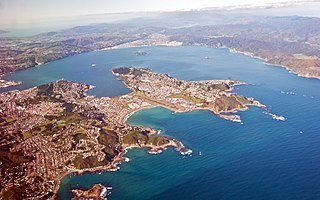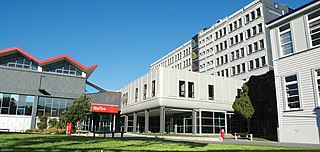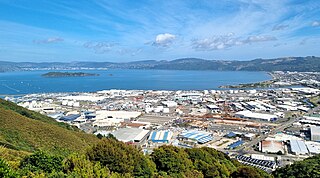
Wellington is the capital city of New Zealand. It is located at the south-western tip of the North Island, between Cook Strait and the Remutaka Range. Wellington is the third-largest city in New Zealand, and is the administrative centre of the Wellington Region. It is the world's southernmost capital of a sovereign state. Wellington features a temperate maritime climate, and is the world's windiest city by average wind speed.

Porirua, a city in the Wellington Region of the North Island of New Zealand, is one of the four cities that constitute the Wellington metropolitan area. The name 'Porirua' is a corruption of 'Pari-rua', meaning "the tide sweeping up both reaches". It almost completely surrounds Porirua Harbour at the southern end of the Kāpiti Coast. As of 2023, Porirua has a population of 62,400 people, and is a diverse city with 26.5% of the population identifying as Pasifika and 23.0% of the population identifying as Māori.

The Hutt Valley is the large area of fairly flat land in the Hutt River valley in the Wellington region of New Zealand. Like the river that flows through it, it takes its name from Sir William Hutt, a director of the New Zealand Company in early colonial New Zealand.

Upper Hutt is a city in the Wellington Region of New Zealand and one of the four cities that constitute the Wellington metropolitan area.

The Hutt Valley campaign was an armed conflict in the lower North Island of New Zealand between indigenous Māori and British settlers and military forces in 1846. The campaign was among the earliest of the 19th century New Zealand Wars that were fought over issues of land and sovereignty. It was preceded by the Wairau affray and followed by the Wanganui campaign and was triggered by much the same pressures—the careless land purchasing practices of the New Zealand Company, armed government support for settler land claims, and complex intertribal tensions between local Māori. The three conflicts also shared many of the same combatants.

The Hutt River flows through the southern North Island of New Zealand. It flows south-west from the southern Tararua Range for 56 kilometres (35 mi), forming a number of fertile floodplains, including Kaitoke, central Upper Hutt and Lower Hutt.

Petone is a large suburb of Lower Hutt, Wellington. It stands at the southern end of the Hutt Valley, on the northern shore of Wellington Harbour.

Wellington Harbour, officially called Wellington Harbour / Port Nicholson, is a large natural harbour on the southern tip of New Zealand's North Island. The harbour entrance is from Cook Strait. Central Wellington is located on parts of the western and southern sides of the harbour, and the suburban area of Lower Hutt is to the north and east.

Stokes Valley, a major suburb of the city of Lower Hutt in the North Island of New Zealand, lies at the edge of the city, seven kilometres northeast of the city centre. It occupies the valley of a small tributary of the Hutt River, called Stokes Valley Stream, which flows north to meet the main river close to the Taitā Gorge. Stokes Valley takes its name from Robert Stokes, who formed part of the original survey team of 1840 commissioned to plan the city at Thorndon in Wellington.
The Petone Rugby Football Club was founded in 1885 and has been the Wellington Premier Champion 39 times between 1895 and 2005. In addition, the club has won the Club Championship on 42 occasions between 1922 and 2005. Petone is a constituent club of the Wellington Rugby Football Union.

The Wellington Institute of Technology, also known as WelTec, is a New Zealand polytechnic based in Petone, Lower Hutt. WelTec was formed in 2001 by an amalgamation between the Central Institute of Technology and the Hutt Valley Polytechnic In 2020, WelTec, along with 15 other national polytechnics, became subsidiaries of Te Pūkenga – New Zealand Institute of Skills and Technology.

Wellington Museum is a museum on Queens Wharf in Wellington, New Zealand. It occupies the 1892 Bond Store, a historic building on Jervois Quay on the waterfront of Wellington Harbour. In 2013, it was voted by The Times as one of the world's 50 best museums.

Lower Hutt is a city in the Wellington Region of New Zealand. Administered by the Hutt City Council, it is one of the four cities that constitute the Wellington metropolitan area.

Waiwhetū is an eastern suburb of Lower Hutt in the Wellington Region situated in the south of the North Island of New Zealand.

Seaview is an industrial suburb of the city of Lower Hutt, in Wellington, New Zealand. Situated on the eastern coast of the Hutt Valley, the suburb lies between Te Awa Kairangi / the Hutt River and Petone, and the bays of Eastbourne to the south. Seaview is a centre for bulk liquid fuel storage for the lower half of the North Island, and a site for heavy industry. It is also a base for support services for trucks and transportation businesses and the location of the wastewater treatment plant for drainage from the Hutt Valley. Seaview is home to the Port Road Drags, the longest-running street drag races in Australasia.

Hōniana Te Puni was a Te Āti Awa leader and government member who played a significant role in the Wellington region in the early to mid 19th century.

The Dowse Art Museum is a municipal art gallery in Lower Hutt, New Zealand.

William Beetham was an English-born portrait painter, who painted mainly in the United Kingdom and New Zealand. He exhibited his paintings at the Royal Academy of Arts in London (1834–53) and painted in Hamburg, Copenhagen and at the court of the Tsar in Saint Petersburg. He emigrated to New Zealand in 1855 and became a significant figure as a colonist, pastoralist and portrait artist. He had a society clientele and received commissions to paint portraits of aristocrats and national leaders, including important Māori Rangatira chiefs. Beetham's paintings are in the permanent collection of the National Portrait Gallery, London and Museum of New Zealand Te Papa Tongarewa in Wellington. He was the founder and Chair of the New Zealand Academy of Fine Arts in 1882. Mezzotint prints of Beetham's drawings are in the permanent collection of the Science Museum, London Beetham's paintings and drawings have also sold at Bonhams auction house.

Point Howard is a suburb on the eastern side of Wellington Harbour, in Lower Hutt, New Zealand.
Te Ara Tupua is a project to construct a 12-kilometre-long (7.5 mi) safe cycling and walking path in New Zealand, between Melling in Lower Hutt and central Wellington. New Zealand Transport Agency / Waka Kotahi (NZTA) leads the project, with involvement from mana whenua Taranaki Whānui and Ngāti Toa, Wellington City Council, Hutt City Council and Greater Wellington Regional Council. The project is divided into three sections: Melling to Petone, Petone to Ngauranga, and Ngauranga to Wellington's central business district. NZTA estimates that by 2030, people will make over 2100 bike trips, 360 walking or running trips and 300 trips on e-scooters on the path each weekday.





















